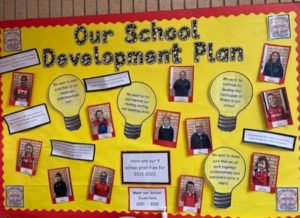 Llanfaes Community Primary School
Llanfaes Community Primary School
Planned strategically over short, medium and longer terms
Information about the school
Llanfaes Community Primary school is located in Brecon, Powys. The school caters for pupils aged between 4 and 11 and has 200 pupils on roll. Attached to the school is a pre-school assessment centre and a 3+ setting.
Approach taken
The School Development Plan had always been based on a variety of stakeholder input (staff meetings, data analysis, questionnaires, listening to learners, Governors) however, complete engagement in the execution of the plans was not consistent across the school. By developing a co-construction approach, ownership, and participation by all was genuine and built on professional learning.

The school co-produces its School Development Plan (SDP) on an annual basis, with stakeholders including practitioners, pupils, parents, school visitors and the governing body contributing to its development. Following its initial development at the start of the academic year, the SDP is displayed on the staff room wall and is updated as time goes on. The SDP is very much a ‘live document’ which can be updated by all school staff, as necessary. Additionally, the school council look at the agreed targets and develop them in ‘child speak’ to assist in the sharing of our goals with the children. These are clearly displayed centrally for all to see.
The school’s performance management and professional development process involves an initial review with teaching staff in October and support staff in January, followed by termly reviews with each practitioner. All performance management reviews are undertaken using the Professional Standards as a framework for professional discussions. Practitioners are expected to undertake a self-assessment against the five areas of the Professional Standards prior to their performance management review. As all practitioners have an input into the development of the SDP, school leaders find that all staff ‘have their eye on the SDP’ whilst undertaking their own self-assessment. Practitioners are expected to identify three areas for development, relating to personal ambition, the SDP and continuous professional development.
A key element has been the establishment of half termly collaborative sessions for staff. Dedicated time is given for staff to work together to plan, discuss and review various elements of their pedagogy or the SDP. A culture of open discussion has been generated facilitating robust conversations in a climate of trust and respect. Additionally, where appropriate, staff have sought support within the cluster or other professional networks to enrich their personal development.
There is a strong alignment between individual ambitions and targets and those set out for the whole school. Opportunities for professional learning are clearly identified for teachers and teaching assistants termly. The value of a varied approach to professional learning is evident, with an increase in the numbers of staff who generate their own opportunities. Professional dialogue is enhanced and focused. A whole school climate of exploration, innovation, mutual trust and respect is evident.

